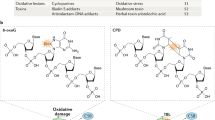Abstract.
Arrest of transcription at sites of DNA damage represents a strong signal for apoptosis. To overcome the impasse represented by transcription complexes arrested at sites of damage, cells have evolved a specialized nucleotide excision repair (NER) pathway called transcription-coupled DNA repair (TCR), dedicated to removal of transcription-blocking lesions from the genome. This repair pathway was discovered in Phil Hanawalt’s laboratory 20 years ago, but the mechanistic details are still subject of intense research. This article will review the recent literature on the subject with emphasis on how lesions affect the elongation step of transcription and how the initial steps of TCR occur in human cells. (Part of a Multi-author Review)
Similar content being viewed by others
Author information
Authors and Affiliations
Corresponding author
Rights and permissions
About this article
Cite this article
Tornaletti, S. DNA Repair in Mammalian Cells. Cell. Mol. Life Sci. 66, 1010–1020 (2009). https://doi.org/10.1007/s00018-009-8738-x
Published:
Issue Date:
DOI: https://doi.org/10.1007/s00018-009-8738-x




